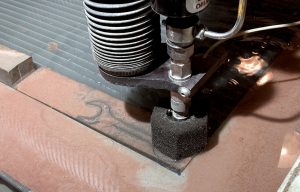
Cutting is synonymous with the manufacturing industry. To convert raw materials and workpieces into finished products, manufacturing companies must typically cut them. Cutting is simply defined as physically separating or opening a solid object. There are several different types of cutting processes, one of which is water jet. Water jet cutting leverages the use of a pressurized stream of water to slice through materials and workpieces. How does water jet cutting work exactly?
Overview of Water Jet Cutting
Water jet cutting is a cutting process that leverages the use of high-pressure water. It’s performed with a special machine known as a water jet. Water jets feature a nozzle and are connected to a water supply line. As water travels through a water jet, it will become pressurized. The pressurized water will then shoot out of a narrow nozzle at the end where it’s able to cut through the underlying material or workpiece.
The material or workpiece is placed underneath the water jet’s nozzle. A worker can then control the direction in which the nozzle travels and when the water is released. As water is ejected out of the nozzle, it will cut through the material or workpiece.
Advantages of Water Jet Cutting
To say water jet cutting is powerful would be an understatement. It’s capable of cutting through some of the toughest materials, including many types of metals. Water cut cutting is powerful because of the extreme pressure at which the water is ejected out of the nozzle. Water pressure can vary depending on the specific water jet. Some water jets use 30,000 pounds per square inch (PSI) of pressure, whereas others use up to 100,000 psi of pressure. Regardless, they are powerful machines that can easily cut through materials and workpieces.
There’s no heat with water jet cutting. The material or workpiece with which a water jet is used will remain cool or at room temperature. Heat, of course, can damage materials and workpieces. When exposed to heat, the physical properties of a material or workpiece may change. Heat can cause warping, weak spots and deformations. Water jet cutting protects materials and workpieces from heat-related damage such as this.
Gas emissions or vapors aren’t a concern with water jet cutting. Water jets simply use water to cut through the materials and workpieces. The same can’t be said for other cutting processes. Some cutting processes use chemicals or gases. While emissions are typically vented, they can build up in the case of faulty equipment.
